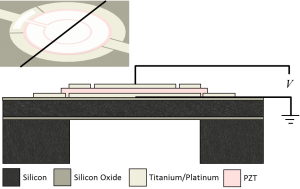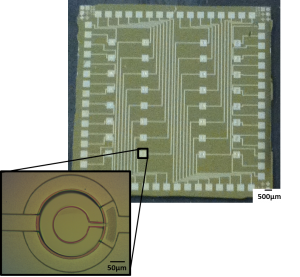Thin Film Piezoelectric Micro-machined Ultrasonic Transducer for Medical Imaging
- Category: MEMS & BioMEMS
- Tags: katherine smyth, sang-gook kim
Ultrasound is an attractive 3D medical imaging technique because it is relatively inexpensive, portable, compact, and non-invasive. However, for 3D real time imaging to be commercially realizable, scans must be consistent and high resolution and occur at a fast acquisition rate–all factors that are inhibited by the current bulk piezoelectric transducer technology[1]. Highly manual manufacturing limits the size of current transducers to millimeter length scales and the high acoustic impedance of the bulk piezoelectric limits resolution reducing bandwidth and sensitivity[2]. At high volume, micro-fabrication is high yield and less expensive, and it would enable element miniaturization for high resolution, small form factor ultrasound probes.
Our group has designed a piezoelectric micro-machined ultrasonic transducer (pMUT) that transmits acoustic signals via high frequency vibrations of a thin diaphragm. These vibrations are actuated by applying a voltage across a thin film piezoelectric lead zirconate titanate (PZT) film deposited via a sol-gel technique. For sensing, acoustic waves reflected from an imaging target strain the diaphragm generating a current signal.
Device fabrication begins with growth of thermal oxide on a silicon-on-insulator wafer. The bottom electrode is then deposited via a lift-off process, and PZT is deposited and patterned with a wet etch. The lift-off process is then repeated to create the top electrode. Finally, diaphragms are released and the substrate is divided into chips (Figure 2) with a back-side deep reactive ion etch. A schematic of the fabricated device is shown in Figure 1.
Through electrode size optimization, our pMUT is designed to maximize deflection, which is ideal for generating the high acoustic pressure necessary to overcome signal attenuation in deep penetration imaging[3]. In the future, we hope to incorporate the optimized pMUT transducer design in pMUT arrays with a small form factor to enable 3D real time medical imaging.
- Figure 1: Schematic of pMUT. Top left: Isometric view of pMUT device with line indicating cut for cross-section diagram. Bottom: Cross-section schematic of completed pMUT.
- Figure 2: Fabricated pMUT chip. Columns form 1D device arrays. Inset: Top view microscope image of completed pMUT.
- B. Khuri-Yakub, O. Oralkan, and M. Kupnik, “Next-Gen Ultrasound,” IEEE Spectrum, vol. 46, no. 5, pp. 44–54, May 2009. [↩]
- T. L. Szabo, Diagnostic ultrasound imaging: inside out, ser. Biomedical Engineering. Elsevier Academic Press, 2004. [↩]
- K. Smyth, S. Bathurst, F. Sammoura, and S. G. Kim, “Analytic Solution for N-electrode actuated Piezoelectric Disk with Application to Piezoelectric Micromachined Ultrasonic Transducers,” IEEE Transactions on Ultrasonics, Ferroelectrics, and Frequency Control, to be published. [↩]

